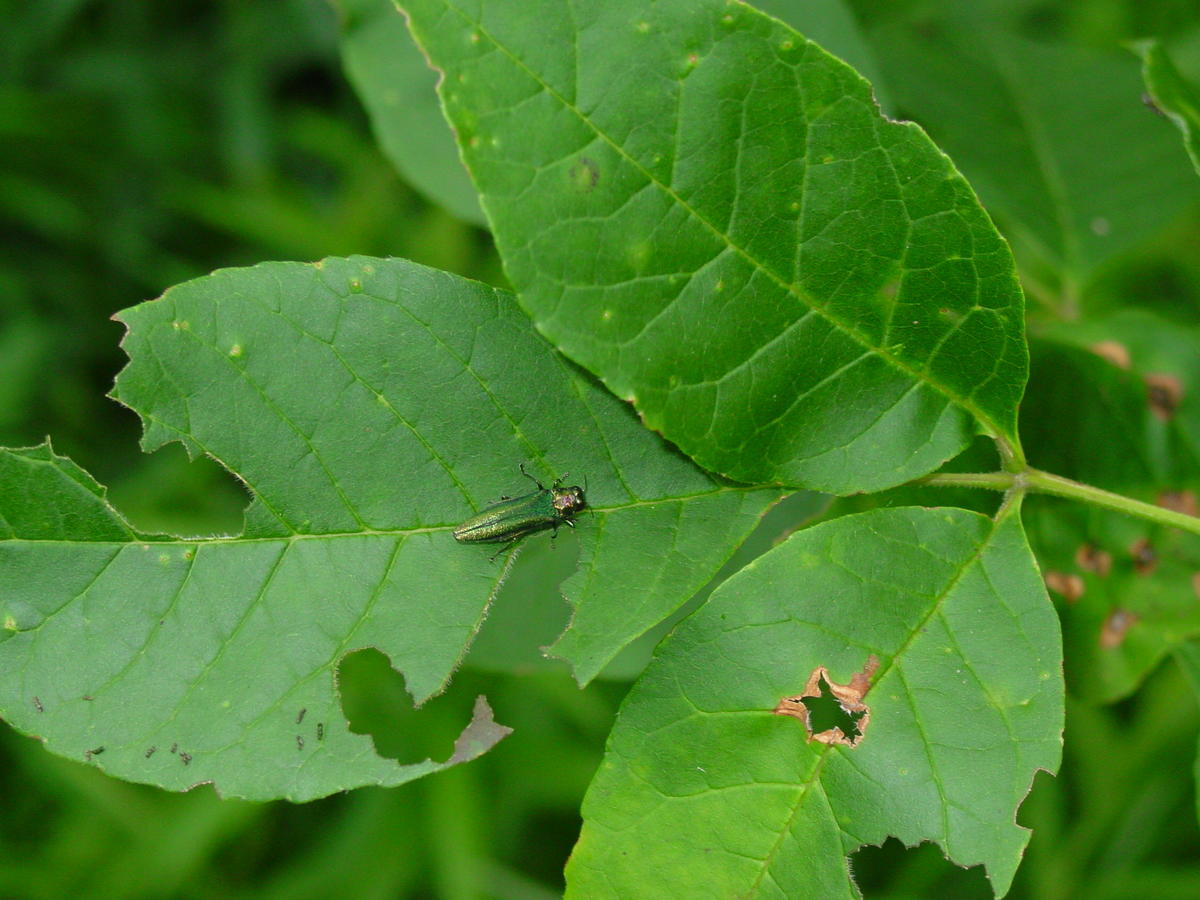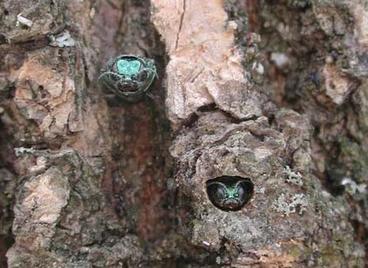Help slow the spread of the invasive insect this spring.
March 8, 2022
by CAROLYN BERNHARDT | MITPPC communications specialist

This post was originally written for the Master Gardener Volunteer News in collaboration with MITPPC scientists Robert Venette, Amy Morey, and Brian Aukema.
What is emerald ash borer?
Nearly 8 percent of the trees in Minnesota are black, green, or white ash, all of them threatened by the invasive insect, emerald ash borer (EAB). EAB kills trees by feeding just beneath the bark, disrupting the ability of the tree to move nutrients and water. Further, EAB carries fungi that can cause additional damage to ash trees.
EAB cost managers across the country an estimated $10.7 billion between 2002 and 2019 to treat, remove, and replace more than 17 million ash trees. These costs do not include the ecological impacts of losing ash in natural stands, which range from losing wildlife habitat to worsening flooded conditions. EAB is a top-ranked invasive species at the Minnesota Invasive Terrestrial Plants and Pests Center (MITPPC) because of its severe economic and ecological impacts.
What can you do?
Learn to identify ash trees

Finding emerald ash borer depends on knowing which trees are ash, in the genus Fraxinus. For more information, see this ash tree identification guide distributed by University of Minnesota Extension.
Scout for EAB
Search your ash trees for signs of EAB now, before summer blooming begins. Spring is your last chance to find evidence of damage before new trees become infested. For more information on how to help scout for, report, and prevent the spread of EAB, visit the UMN Extension website.
Burn firewood responsibly
Transporting firewood is a key vehicle for EAB spread. Without the boost from firewood movement, the beetles will generally move on their own only about 1/2 to 1 mile per year from infested sites. So, as you plan your summer camping trips, remember to buy only firewood that is certified by the Minnesota Department of Agriculture or buy your firewood as close as possible to where you plan to burn it.
Manage infested ash trees effectively
Clearcutting and the selective removal of small groups of infested trees, with or without replanting, are currently the most common ways to slow the spread of EAB. But tree removal, especially in masses, feels like such a big loss. Fortunately, researchers at MITPPC are advancing on ways to manage the invasive insect without sacrificing trees. Last year, they made great strides in several important areas.
Note: For Minnesota counties within the EAB quarantine, there are disposal sites for ash wood. Check out the site in your area here. In addition, if you think you might have EAB on your property, please report it to the MDA promptly.
EAB research at MITPPC
Investigating EAB’s fungal “consorts”
MITPPC-funded scientists recently published their findings from studying the fungi associated with EAB. This research team, made up of members of the Blanchette Lab, was able to identify the fungi, and the fungal diseases caused by EAB infestation, that help the beetle harm ash trees. This information serves as a first step in developing an effective, fungi-based biocontrol option for EAB in Minnesota—if researchers can find a way to kill the fungi, they can help diminish the pest’s overall impact on trees. Read more on EAB and fungi.
Creating ash tree “herd immunity” to EAB
Research from the Aukema Lab at the University of Minnesota suggests that injecting a subset of trees with anti-EAB insecticides can help protect untreated nearby trees. The researchers are trying to find strategies to reduce potential impacts to non-target organisms while preserving the urban canopy with even lower insecticide inputs. So, they are using non-neonicotinoid insecticides. Every year since 2017, the team has investigated 12 different sites of 100 trees or more in areas where EAB was active. They found that uninjected trees have been staying alive longer than expected because of their proximity to trees treated with the insecticide. Larvae dying in cold snaps from recent winters could also be slowing tree decline from EAB, but the team is seeking to find out more. Read more on EAB tree injections.
Confirming the safety and efficacy of insecticides
Researchers in the Aukema Lab have also been testing to see how two common, non-neonicotinoid insecticides used against EAB affect ash trees. The team wanted to see whether insecticides that protect against EAB infestations alter the normal seasonal events of trees, as changes to these events could disrupt interactions of other important insects that interact with ash trees. They found that the insecticides do not alter a tree's normal life cycle, and actually protect against subtle delays in leaf flush (which is when EAB first attacks the trees). One of the insecticides also provided good protection against seed weevils that destroy ash seeds.
Assessing the acceptability of different management options
Researchers in the Schneider Lab are harnessing the power of augmented reality and virtual reality to help recreationists visualize what different management options for EAB would do to forests. Then, the research team can ask participants which outcomes they preferred. Normally, such preference surveys depend on people’s knowledge of EAB and different management strategies. However, it can be hard to imagine what management looks like and how compatible it is with a user’s desired experience. This project is the first of its kind to use immersive technologies to explore natural resource management preferences. Read more on visitor perceptions of managing EAB.
MITPPC research is funded by the Minnesota Environment and Natural Resources Trust Fund as recommended by the Legislative-Citizen Commission on Minnesota Resources (LCCMR).